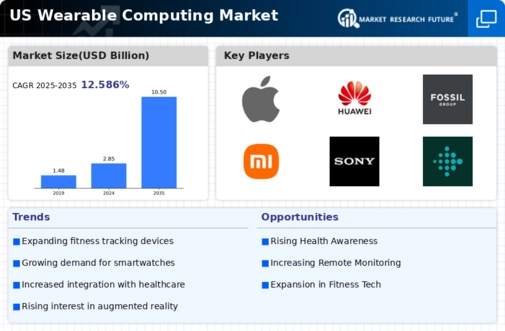The US Wearable Computing Market is characterized by rapid technological advancements and evolving consumer preferences, driving significant competition among industry players. This dynamic environment has allowed companies to innovate continually, offering consumers a diverse range of products designed to enhance convenience, connectivity, health tracking, and overall lifestyle improvements. With the penetration of smartphones and the Internet of Things, wearable devices such as smartwatches, fitness bands, and augmented reality glasses have become integral parts of everyday life. The competition in this sector is fierce, as companies strive to differentiate themselves through unique features, robust applications, and strategic branding efforts.
Understanding the competitive landscape is essential for stakeholders aiming to capitalize on growth opportunities in this vibrant market.
Apple has established a formidable presence in the US Wearable Computing Market, primarily through its smartwatch offerings, which have garnered significant market share and consumer loyalty. The combination of Apple's robust ecosystem, seamless integration with iPhones, and powerful health-focused features positions the company as a leader in this space. The strengths of Apple lie in its brand reputation for quality, innovation, and design, making its products highly desirable among consumers. Moreover, Apple's extensive marketing strategies and retail presence ensure wide accessibility and visibility of its wearable devices, further cementing its dominance in the market.
The company continually invests in research and development to enhance user experience, making the Apple Watch a compelling option for fitness enthusiasts and casual users alike.
In the US Wearable Computing Market, Huawei presents a growing presence, driven by its array of smartwatches and fitness trackers that emphasize health and fitness monitoring features. Huawei's key products resonate well with price-sensitive consumers looking for reliable wearables that do not compromise on functionality or design. The company has focused on expanding its market reach by offering devices equipped with advanced health-tracking capabilities, appealing to a broad demographic. Huawei's strengths include its diverse product lineup and focus on delivering competitive pricing, which allows for a variety of options for consumers.
Despite facing challenges related to its reputation and market perception in the US, Huawei's commitment to innovation is evident through its product launches and updates. The company seeks to enhance its presence through strategic partnerships and focused marketing efforts, aiming to effectively navigate the competitive landscape of wearable technology in the US.






















